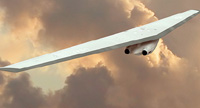USA develops unmanned shape-changing ultrasonic bomber plane to substitute aging warheads
Today when the international community is speaking about nuclear disarmament American scientists are trying their best to develop new and much deadlier technologies to substitute its aging warheads.

For years, the U.S. military has wanted a plane that could loiter just outside enemy territory for more than a dozen hours and, on command, hurtle toward a target faster than the speed of sound. And then level it. But aircraft that excel at subsonic flight are inefficient at Mach speeds, and vice versa. The answer is Switchblade, an unmanned, shape-changing plane concept under development by Northrop Grumman.
When completed (target date: 2020), it will cruise with its 200-foot-long wing perpendicular to its engines like a normal airplane. But just before the craft breaks the sound barrier, its single wing will swivel around 60 degrees (hence the name) so that one end points forward and the other back. This oblique configuration redistributes the shock waves that pile up in front of a plane at Mach speeds and cause drag. When the Switchblade returns to subsonic speeds, the wing will rotate back to perpendicular.
Smart plan. Now for the hard part: designing the thing. Darpa, the Pentagon’s way-out research arm, has coughed up $10.3 million to Northrop Grumman to produce a detailed blueprint by November 2007. A flying test vehicle is due about four years later. The initial concept calls for a single wing with engines situated in a pod underneath, along with munitions and surveillance equipment. This setup will enable the wing to pivot while the engines remain pointed in the direction the craft is traveling.
This is not the first attempt at an oblique-wing aircraft. SpaceShipOne creator Burt Rutan designed a switch-wing plane with NASA in 1979. But the slanted wings made the craft hard to fly—when the pilot pulled the nose up, the plane would roll to one side.
The Switchblade, however, is a good candidate to be an unmanned aerial vehicle (UAV). The artificial intelligence used to control UAVs can handle the tricky flight dynamics, and a computer pilot doesn’t need to eat, rest, or go to the bathroom — useful for those 15-plus-hour missions.
If all goes well, Darpa says, a 40-foot-wingspan demonstration model could be ready by 2010, and a full-size Switchblade should be all set for a brawl by 2020.
With its long, thin wing in a standard configuration, the Switchblade can maintain subsonic-speeds for at least 15 hours as it waits for a mission. And with its wing cocked forward, the Switchblade flies at Mach 2 toward a target up to 2,500 nautical miles away.
In February 2006 Popular Science Magazine published an article about Navy’s swimming spy plane, The Cormorant.
The Cormorant, a stealthy, jet-powered, autonomous aircraft that could be outfitted with either short-range weapons or surveillance equipment, is designed to launch out of the Trident missile tubes in some of the U.S. Navy’s gigantic Cold War–era Ohio-class submarines. These formerly nuke-toting subs have become less useful in a military climate evolved to favor surgical strikes over nuclear stalemates, but the Cormorant could use their now-vacant tubes to provide another unmanned option for spying on or destroying targets near the coast.
The Cormorant does not shoot out of its tube like a missile. Instead an arm-like docking “saddle” guides the craft out, sending it floating to the surface while the sub slips away. As the drone pops out of the water, the rocket boosters fire and the Cormorant takes off. After completing its mission, the plane flies to the rendezvous coordinates it receives from the sub and lands in the sea. The sub then launches a robotic underwater vehicle to fetch the floating drone.
The Defense Advanced Research Projects Agency (Darpa) is funding tests of some of the Cormorant’s unique systems, including a splashdown model and an underwater-recovery vehicle. The tests should be completed by September, after which Darpa will decide whether it will fund a flying prototype.
Both these articles show that the USA speaking about nuclear disarmament is trying to develop new and more dangerous weapons to substitute its warheads. These new technologies can play a crucial role in future arms race.
Source: Popular Science
Prepared by Alexander Timoshik
Pravda.ru
Discuss this article on Pravda.ru English Forum
Subscribe to Pravda.Ru Telegram channel, Facebook, RSS!




